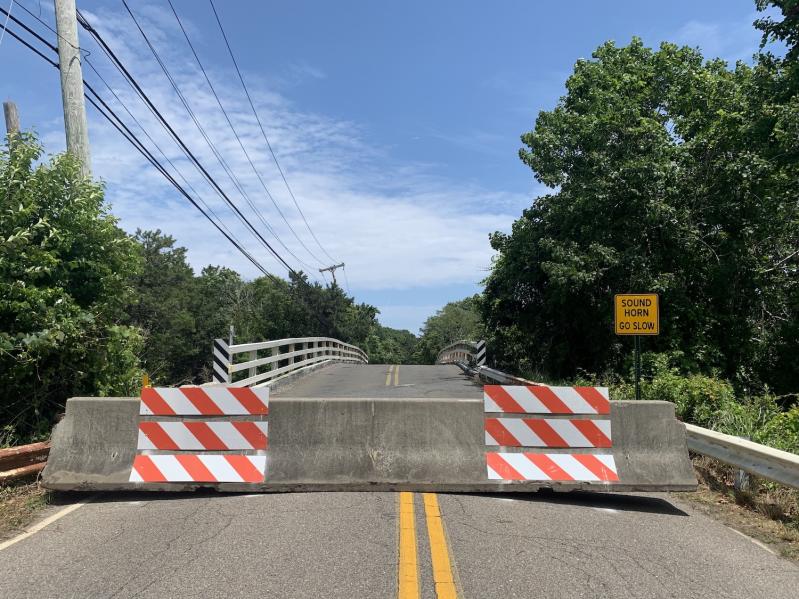“I have never seen such a large turnout,” marveled Rona Klopman, chairwoman of the Amagansett Citizens Advisory Committee, taking in a standing-room-only crowd on Monday night at the Amagansett School.
Many of the 50 or so faces in the room were unfamiliar — there, it became apparent, for just one reason: To hear the evening’s speaker, State Assemblyman Tommy John Schiavoni, address them on the rebuilding of the Cranberry Hole Road Bridge, which was closed by the town in 2023 as “structurally deficient.”
When Mr. Schiavoni finished speaking, the new people arose as one and left, having made it clear that they all live in the hamlet’s easternmost reaches — Devon, Lazy Point, parts of Napeague — where the loss of the bridge has had the most adverse consequences.
After years of officials wrangling over which agency is chiefly responsible for replacing the bridge — East Hampton Town or the Metropolitan Transportation Authority — Mr. Schiavoni had the answer: It’s the M.T.A.
“I am the only elected official on Long Island who voted to fully fund the M.T.A. capital plan,” he began, adding (but modestly not drawing the connection out loud) that “we have been successful in getting onto [the plan].”
The five-year capital plan, a big part of the recently enacted New York State budget, is aimed mainly at improving subway, bus, and commuter rail systems, but it also covers bridges and tunnels. “It’s a long list,” the assemblyman warned — “light rail in Brooklyn, Queens, Westchester, Nassau, and Suffolk Counties,” including upgrades to the Speonk-to Montauk line. The subtext: Replacing a bridge at the far end of eastern Long Island may not be the M.T.A.’s top priority.
And yet there is hope. “Your bridge is now at the top of the list,” Mr. Schiavoni told the crowd, “but the pace is glacial.”
The local bridge, he said, has been lumped in with two others nearby, one in Sagaponack and one in Eastport. “The M.T.A. is looking at these three as one project . . . they told me the stages of the bridges will be engineered and done at the same time . . . they are going to buy the beams and stuff together.”
Each new bridge is expected to cost between $20 million and $25 million. “The big news is that they are about to go out” to requests for proposals “for engineering and construction estimates.”
“How soon?” someone yelled.
“Shortly. This project is underway, and they will be putting it out soon.”
“Can you put together a timeline?”
“No.”
“So we can be here again next year?”
“Yes.”
“I don’t know the time to the beginning of construction,” he said later, “but they did tell me that once construction starts, it’s nine months to finish.”
Jaine Mehring, a member of ACAC, commented that the Cranberry Hole Road Bridge, built in 1895 across the railroad tracks, is on the National Register of Historic Places, and wondered if that would be taken into consideration when designing its replacement. Mr. Schiavoni did not address the question, other than to note that none of the new bridges will have a weight restriction, and fire trucks will be able to cross. (There was such a restriction on the local bridge, of 10,000 pounds, but many heavy trucks ignored the sign, contributing to its deterioration.)
Several of the new faces in the room seemed unwilling to let the matter rest there, pressing for some sort of “temporary” solution.
“Make a railroad crossing out of it,” one man suggested.
Dawn Brophy, ACAC’s secretary, was having none of that. “I live nearby, and you will have pushback from the neighbors,” she said.
“Temporary bridges are a thing,” someone else offered. “It might help us get through the long M.T.A. process.”
That would require private financing to hire an architect, a contractor, and so forth, all agreed. Would the town contribute?
“Do you really want to pay for this?” asked Mr. Schiavoni. “Are you up for kicking in $700,000, $1 million?”
“I need to gauge the folks in the room,” he added. “Because, you know what? They’ll put in a ‘temporary’ bridge and leave it there for 50 years. Do you expect the town to pay?”
“Yes, I do,” was the answer. “The decision to shut the bridge was rash. We can’t change it, but we can ask the town to help.”
“Rash” wasn’t quite fair, Mr. Schiavoni suggested. “The bridge is dangerous.”
The resident pressed on. “I think temporary should be looked at,” he insisted. “I’d like to see a legal analysis as to whether we have the right to challenge.”
The crowd murmured. Mr. Schiavoni looked bemused, and for a minute it seemed as if the evening might end in civil disobedience, but Vicki Littman, ACAC’s vice chairwoman, broke in. “Tommy John is working for us,” she reminded the crowd. “I would love to have an M.T.A. person here, but . . . “
A new voice piped up: “I would like to suggest that the town appoint a task force to look at temporary solutions.”
Mr. Schiavoni shook his head. “Keep in mind that we’re in competition with Manhattan, Westchester, Nassau . . .
Another audience member had the last word. “If a temporary fix puts us further down a waiting list, it makes it more difficult to get the real fix,” he said.
“I knew coming in here that I didn’t have a lot of information for you,” Mr. Schiavoni said in conclusion, “but they did tell me they are in the process. I was very vocal about fully funding the M.T.A., and we are moving this thing forward.”
A mass exodus followed, as Alexander (Sas) Peters of Stony Hill Road stepped forward to deliver a strong plea for the preservation of the Long Island aquifer, which runs below that area. Mr. Peters criticized the town board for its recent purchase of vacant land on Georgica Pond — “so rich people can have better views” — saying the town should instead have bought four acres on Stony Hill. He also condemned spending tax dollars on the new senior citizens center.
In other Amagansett news, it was reported here a few weeks ago that the hamlet’s proposed new street lights, which the town board has so far approved, would be installed between Indian Wells Highway and Meeting House Lane. That has been since been clarified: The new lighting will run from Indian Wells all the way to the train station.




